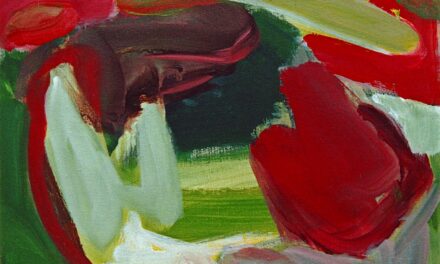De Stijl, which translates to “The Style” in English, was an influential art movement that originated in the Netherlands in the early 20th century. The movement was founded in 1917 by a group of artists and architects, including Theo van Doesburg, Piet Mondrian, and Gerrit Rietveld, amongst others. De Stijl emerged as a response to the chaos and destruction of the First World War, with its members seeking to create a new visual language that reflected the ideals of harmony, order, and simplicity.
The movement was deeply influenced by the principles of Neoplasticism, which advocated for the use of geometric forms and primary colours to achieve a universal visual language that transcended cultural and national boundaries. De Stijl was not merely an art movement, but also a philosophical and theoretical approach to art and design. The members of De Stijl sought to create a new aesthetic that could be applied to all aspects of life, from architecture and furniture design to painting and graphic design.
They believed that by embracing a simplified and abstract visual language, they could create a more harmonious and balanced world. The movement’s manifesto, written by Theo van Doesburg in 1918, outlined the group’s principles and goals, emphasising the importance of pure abstraction, asymmetry, and the use of primary colours. De Stijl’s influence extended beyond the visual arts, impacting architecture, urban planning, and even typography.
The movement’s impact can still be observed today in the clean lines and geometric forms of modern design.
Summary
- De Stijl was founded in 1917 in the Netherlands by Theo van Doesburg and Piet Mondrian, with the aim of creating a new artistic language.
- Key principles of De Stijl include the use of geometric forms, primary colours, and a focus on abstraction and simplicity.
- De Stijl had a significant influence on architecture, graphic design, and furniture design, with its emphasis on functionalism and the integration of art into everyday life.
- Famous artists associated with De Stijl include Theo van Doesburg, Piet Mondrian, and Gerrit Rietveld, who designed the iconic Red and Blue Chair.
- De Stijl’s legacy can be seen in the modernist movement and its impact on the development of minimalism, constructivism, and the Bauhaus school of design.
Key Principles and Characteristics of De Stijl
Geometric Forms and Primary Colours
One of the fundamental principles of De Stijl was the utilisation of geometric forms and primary colours to create a universal visual language. Artists associated with the movement, such as Piet Mondrian, sought to reduce their compositions to the most basic elements, employing straight lines, rectangles, and squares to create a sense of order and harmony. This approach was known as Neoplasticism, and it aimed to express the underlying harmony of the universe through abstract forms and colours.
The Significance of Primary Colours
The use of primary colours – red, blue, and yellow – was also central to the movement’s aesthetic, as these colours were seen as the most fundamental and pure. Another important characteristic of De Stijl was its emphasis on asymmetry and balance. Artists associated with the movement sought to create compositions that were visually balanced without being symmetrical.
Philosophical Goals and Applications
This approach reflected the movement’s broader philosophical goals of creating a more harmonious and balanced world through art and design. In addition to painting, De Stijl’s principles were also applied to architecture and design. Gerrit Rietveld, a key figure in the movement, designed furniture that embodied the principles of De Stijl, using simple geometric forms and primary colours to create functional yet visually striking pieces.
The Influence of De Stijl on Art and Design

De Stijl had a profound influence on the development of modern art and design. The movement’s emphasis on abstraction, simplicity, and harmony paved the way for the development of abstract art in the 20th century. Artists associated with De Stijl, such as Piet Mondrian, had a significant impact on the development of abstract painting, inspiring generations of artists to explore the potential of geometric forms and primary colours in their work.
The movement also had a lasting impact on design, particularly in the fields of architecture and furniture design. Gerrit Rietveld’s iconic Red and Blue Chair, designed in 1917, remains a symbol of the movement’s influence on modern furniture design. De Stijl’s influence extended beyond the Netherlands, reaching artists and designers around the world.
The movement’s emphasis on universal principles and its rejection of nationalistic or cultural influences made it appealing to artists seeking to create a new visual language that transcended traditional boundaries. De Stijl’s impact can be seen in the work of artists such as Theo van Doesburg, who spread the movement’s ideas through his travels and writings. The principles of De Stijl also had a significant impact on the development of modern typography, with its emphasis on simplicity and clarity influencing the work of designers such as Jan Tschichold.
Famous Artists and Figures Associated with De Stijl
Piet Mondrian is perhaps the most famous artist associated with De Stijl. His iconic compositions featuring grids of black lines intersecting with blocks of primary colours have become synonymous with the movement’s aesthetic. Mondrian’s work had a profound impact on the development of abstract art in the 20th century, inspiring countless artists to explore the potential of geometric forms and primary colours in their work.
Another key figure in De Stijl was Theo van Doesburg, who played a crucial role in spreading the movement’s ideas through his writings and travels. Van Doesburg’s manifesto for De Stijl outlined the group’s principles and goals, emphasizing the importance of pure abstraction and asymmetry. Gerrit Rietveld was a prominent architect and designer associated with De Stijl.
His iconic Red and Blue Chair, designed in 1917, remains one of the most recognisable symbols of the movement’s influence on modern furniture design. Rietveld’s use of simple geometric forms and primary colours embodied the principles of De Stijl, creating functional yet visually striking pieces that continue to inspire designers today. Other notable figures associated with De Stijl include Bart van der Leck, Vilmos Huszár, and J.J.P Oud, all of whom played important roles in shaping the movement’s aesthetic and spreading its influence.
De Stijl’s Legacy and Impact on Modern Art and Design
The legacy of De Stijl can be seen in the continued influence of its principles on modern art and design. The movement’s emphasis on abstraction, simplicity, and harmony paved the way for the development of abstract art in the 20th century, inspiring generations of artists to explore the potential of geometric forms and primary colours in their work. De Stijl also had a lasting impact on design, particularly in the fields of architecture and furniture design.
Gerrit Rietveld’s iconic Red and Blue Chair remains a symbol of the movement’s influence on modern furniture design, while its principles continue to inspire designers seeking to create functional yet visually striking pieces. The international reach of De Stijl ensured that its influence extended far beyond the Netherlands, reaching artists and designers around the world. The movement’s emphasis on universal principles and its rejection of nationalistic or cultural influences made it appealing to artists seeking to create a new visual language that transcended traditional boundaries.
De Stijl’s impact can be seen in the work of artists such as Theo van Doesburg, who spread the movement’s ideas through his travels and writings. The principles of De Stijl also had a significant impact on the development of modern typography, with its emphasis on simplicity and clarity influencing the work of designers such as Jan Tschichold.
The International Reach of De Stijl

Influence on Modern Art and Design
The principles of De Stijl also had a significant impact on the development of modern typography. Designers such as Jan Tschichold were influenced by the movement’s emphasis on simplicity and clarity, incorporating these principles into their own work. The international reach of De Stijl ensured that its influence extended far beyond Europe, reaching artists and designers in countries such as Japan and the United States.
A Universal Appeal
The movement’s universal appeal made it an important force in shaping modern art and design around the world.
Lasting Legacy
De Stijl’s influence can still be seen today, with its emphasis on simplicity, abstraction, and harmony continuing to inspire artists and designers worldwide.
Exploring De Stijl in Contemporary Art and Design
While De Stijl emerged in the early 20th century, its influence can still be seen in contemporary art and design. The movement’s emphasis on abstraction, simplicity, and harmony continues to inspire artists seeking to create a new visual language that transcends traditional boundaries. Contemporary artists such as Bridget Riley have been influenced by the principles of De Stijl, using geometric forms and primary colours to create visually striking compositions that reflect the movement’s aesthetic.
In addition to painting, De Stijl’s principles continue to have an impact on contemporary design. The movement’s emphasis on universal principles has inspired designers seeking to create functional yet visually striking pieces that embody the ideals of harmony and balance. The legacy of De Stijl can also be seen in contemporary architecture, with its emphasis on clean lines and geometric forms shaping modern buildings around the world.
Overall, De Stijl’s influence continues to be felt in contemporary art and design, inspiring artists and designers to explore new ways of creating harmony and balance through abstraction and simplicity.
If you are interested in learning more about the evolution of art movements, you may want to read about Post-Impressionism. This artistic style emerged in the late 19th century and was a reaction against the naturalism of Impressionism. Post-Impressionist artists, such as Vincent van Gogh and Paul Cézanne, focused on the use of bold colours and expressive brushstrokes to convey emotion and meaning in their work. To read more about Post-Impressionism, visit this article.
FAQs
What is De Stijl?
De Stijl, which translates to “The Style” in English, was a Dutch artistic movement founded in 1917. It was focused on abstract art, architecture, and design, and sought to create a universal visual language that could be understood by all.
Who were the key figures of De Stijl?
The key figures of De Stijl were the Dutch artists Theo van Doesburg, Piet Mondrian, and Gerrit Rietveld. They were instrumental in shaping the movement’s principles and promoting its ideas through their work and publications.
What were the principles of De Stijl?
De Stijl was based on the principles of geometric abstraction, using only straight lines, rectangular forms, and primary colors. The movement aimed to achieve a sense of harmony and order through these elements, reflecting the ideals of the modern age.
How did De Stijl influence art and design?
De Stijl had a significant impact on art, architecture, and design, both in the Netherlands and internationally. Its principles influenced the development of modernist architecture and design, and its ideas continue to be influential in contemporary art and design practices.
What is the legacy of De Stijl?
The legacy of De Stijl is seen in its lasting influence on modern art, architecture, and design. Its principles continue to inspire artists and designers, and its impact can be seen in the development of abstract art and modernist design movements.




